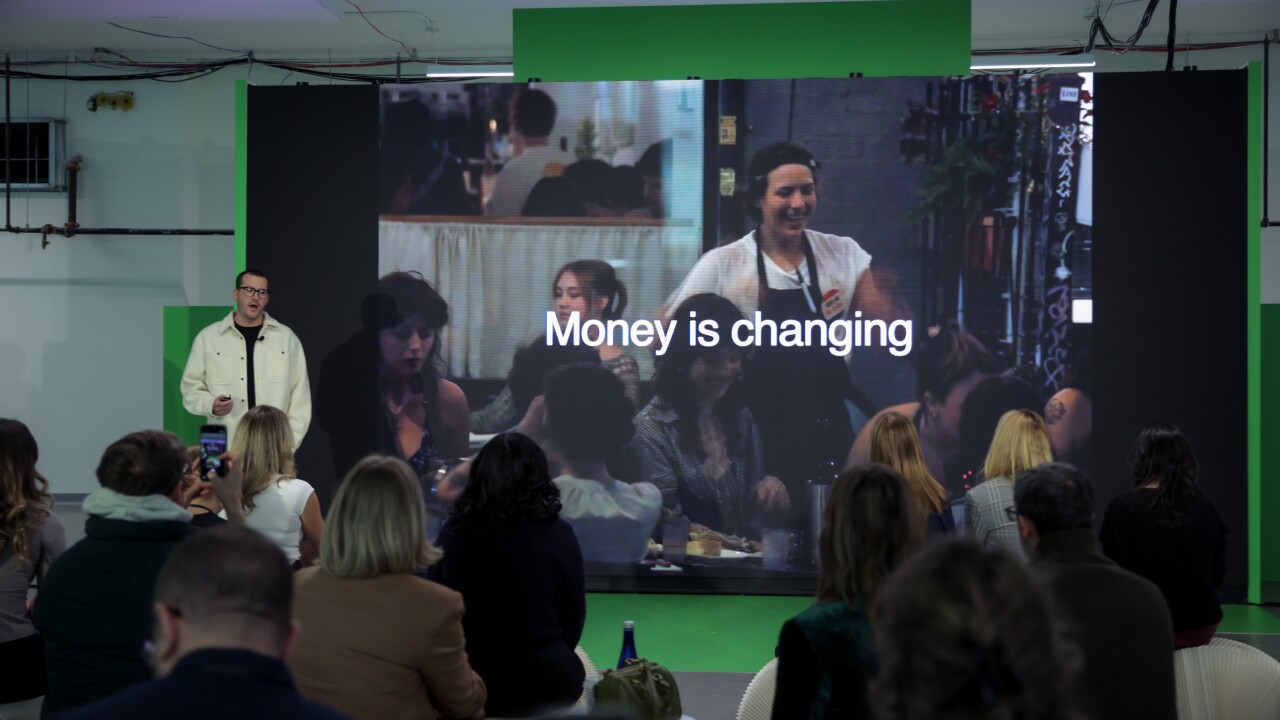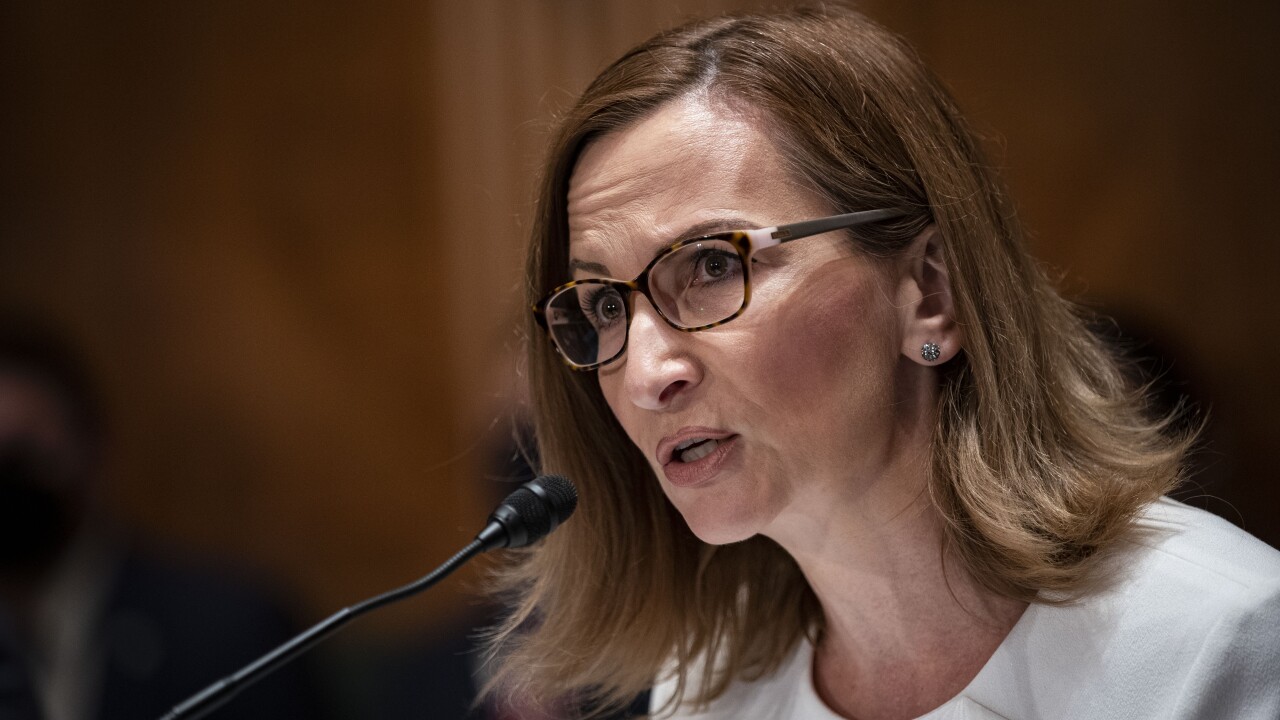
What's hot — and what's not — in retail banking: A midyear update
Already, the nation’s largest bank, JPMorgan Chase, has rolled out a digital-only bank — dubbed Finn — that primarily targets consumers in markets where it lacks branches. Several of its rivals, including Citigroup, Citizens Financial Group and PNC Financial Services Group, are following suit.
These banks detailed their plans for their new digital offerings at an investor conference in New York this week hosted by Morgan Stanley. Their strategies differ somewhat — Citizens is targeting consumers nationwide, said Brad Conner, its head of consumer banking (above, center), while PNC is focused on attracting clients in markets where it does commercial lending. But banks developing these new digital platforms all share the same goal: to gain a competitive edge in the never-ending quest for low-cost deposits.
Deposit-gathering was perhaps the biggest topic of discussion at the two-day conference.
It has been well documented that the
The conference also featured plenty of discussion about mergers and acquisitions, the state of mortgage lending in a rising-interest-rate environment — Wells Fargo's John Shrewsberry, left, is a bit bearish — and the evolving role of the bank branch. What follows are some of the highlights from the conference.

Counting on digital-only affiliates to drive deposit growth
Brad Conner, the head of consumer banking at the $158 billion-asset Citizens, said Tuesday that he expects most of those deposits to come from outside its 13-state footprint in the Northeast and upper Midwest. Its target market, he added, will be “digitally savvy” consumers who “tend not to use the branch networks.”
Citizens Access will offer only high-yield savings accounts and certificates of deposit for now, and Conner said that depositors will not be able to do any of their banking through the branch network.
Citizens Access is in a live pilot right now with employees and will officially launch this summer, Conner said.

Digital first, branches later?
Unlike Citizens, Citi does not intend to try and attract new depositors by enticing them with rates higher than those offered through its branches, Gerspach said.
“We’re not looking as though we’re going to lead by raising rates on deposits,” he said. “What we’re looking to do, as I said, is actually build relationships with existing credit card customers and people that know us already. We like to think that we know what they value, and there are other things that they value beyond interest rates.”
Gerspach added that Citi may “augment” its digital bank with branches down the road. For instance, if it notices a concentration of users in a particular area, it may add a branch that focuses on wealth management.
The company, however, has no imminent plans to do so. “That would be something for another day,” Gerspach said.
PNC Financial Services Group is also rolling out a digital bank this year, primarily in markets where it has no retail presence but does do commercial lending, such as Kansas City and Dallas. If the digital strategy proves successful, it will likely add some branches in those markets, Chief Financial Officer Robert Reilly said.
“Our data tells us that only 10% of the U.S. consumer population contemplates a 100% digital offer,” Reilly said. “But possibly as high as 50% or greater are willing to take a predominantly digital offer supported by some branch. So that's the model that we're looking to deploy in these markets.”

Customers still want to visit branches — but mostly just to get advice
At Bank of America — which earlier this year announced a
Over the same period, transaction-related visits, in which customers deposited a check, for instance, have fallen by about 25%, Athanasia said.
As of March 31, BofA had 4,435 branches, or 3% fewer than a year earlier.
BofA has redesigned many of its branch layouts to facilitate the shift. Like many of its competitors, the company has ditched teller lines and carved out space for client meetings. It has even eliminated “teller” as a job title, opting instead for “customer service rep,” according to Athanasia.
In its presentation, U.S. Bancorp also emphasized advice as the primary offering at modern bank branches.
“People want to talk to someone eyeball to eyeball when they want to understand what type of mortgage they want. Is it fixed or floating? How do I think about my retirement savings?” said Andy Cecere, the chairman and CEO of the Minneapolis company.
U.S. Bancorp has just over 3,100 branches, according to the Federal Deposit Insurance Corp. Over the past few years, it has shrunk its total branch count by about 1% per year, executives said.
Citizens Financial, meanwhile, is looking at revamping its footprint, using three different layouts: small, self-service branches; traditional, full-service branches; and branches that are mainly designed for giving advice to small businesses and wealth management customers.
“We believe the branch has a role to play long term in consumer banking,” said Brad Conner, its head of consumer banking. “But we see the shape of the branch changing over time.”

The changing economics of M&A
“We certainly would be willing to look at M&A, but the economics of M&A have really changed,” King said when asked about BB&T’s appetite for acquisitions.
BB&T’s last two acquisitions, in 2016 and 2017, were in central and southeastern Pennsylvania, a state where it had previously had no presence. Now, King said, it would only be interested in buying banks in markets where it already does business so it could both build on in existing market share and save money by closing overlapping branches.
As King sees it, banks that buy their way into new markets risk overpaying because pricing has yet to take into account the fact that cash flow at branches is declining.
“Today if we were looking, for example, at an out-of-footprint deal, it's almost impossible to make the numbers work,” he said. “The market is already pricing that bank higher than I'm willing to pay because the market doesn't get to completely understand what's going on with regard to the nature of branch banking.”
Early in 2017, BB&T
The FDIC did not identify any criminal activity associated with those problems, nor did it fine BB&T, but the consent order has hampered its ability to expand. Though BB&T has continued to make acquisitions in its insurance business, most recently agreeing to buy
King has said that he expects the company to be released from the consent order soon.

Old-fashioned strategies: Play up CDs, add bankers
During recent years when the industry was flush with liquidity, bankers and investors frowned upon CDs because they increased banks’ interest expense. Now, with interest rates rising and rate-chasers coming out of the woodwork, CDs are seen as more valuable due to their stability.
“It really does provide a lot more predictability, as far as the cash flows and deposit balances,” Kimble said at the Morgan Stanley conference on Tuesday.
KeyCorp views CDs as a vehicle to pay higher deposit rates to customers without having to also boost rates on core deposit products like money markets, he said.
KeyCorp’s CD balances had been plummeting as the bank de-emphasized them. Time deposits of at least $250,000 dropped to 1.48% of total deposits in the first quarter of 2017, a 10-year low. Since then, time deposits of at least $250,000 have increased to 2.43% of total deposits, and Kimble said that he expects the growth to continue.
Signature Bank in New York is looking to boost deposits by opening a new office in San Francisco — its first outside of the New York City area — and adding teams of bankers along the West Coast.
The bank has already hired several veteran bankers in market and Eric Howell, the executive vice president of corporate and business development, said it expects to announce the hiring of several more teams this summer.
Signature’s primary aim for setting up shop on the West Coast is gathering deposits and it has no intention of making commercial real estate loans there, Howell said.

Discover: Taking advantage of swipe-fee loophole
Unlike its peers, the Riverwoods, Ill.-based company now offers cash rewards on debit card purchases. Checking account holders are eligible to receive 1% cash back on up to $3,000 in debit card purchases each month.
The firm’s chief operating officer, Roger Hochschild, said Wednesday that Discover is able to offer those cash rewards because, unlike other large and midsize banks, it is not subject to the regulatory cap on debit card swipe fees. He said the advantage stems from the fact that Discover operates a payments network.
Discover plans to start marketing the checking account more aggressively in the second half of the year.
Historically, the firm has relied less heavily on deposit funding than some of its competitors in the credit card business.
“Realistically, it will take a while for it to be a meaningful portion of our funding,” Hochschild said.

Wells Fargo: Bearish (for now) on mortgages
“We’re in it forever,” Chief Financial Officer John Shrewsberry said.
Rising mortgage rates have already shrunk the pool of home owners looking to refinance their existing loans.
Shrewsberry said that if rates continue to climb, the home purchase market will probably also contract.
“Unless employment remains as strong as it has been, and a preference for ownership increases from where it is, and available supply ticks up also, my guess is higher rates mean a smaller mortgage market,” he said.
Laura Alix, Kristin Broughton, Frank Gargano, Andy Peters and Kevin Wack contributed to this slideshow.





